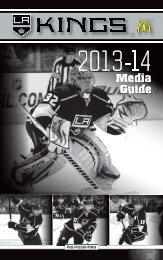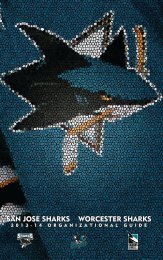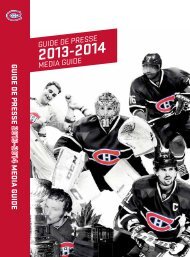2013-14 MEDIA GUIDE
new jersey devils 2013-14 media guide - New Jersey Devils PR
new jersey devils 2013-14 media guide - New Jersey Devils PR
- No tags were found...
Create successful ePaper yourself
Turn your PDF publications into a flip-book with our unique Google optimized e-Paper software.
meDICAL GLOSSARY<br />
318<br />
AC Joint: Acromioclavicular joint, joint of the<br />
shoulder where acromion process (tip of the<br />
scapula) and the distal end of the clavicle meet:<br />
most shoulder separations occur at this point.<br />
Adhesion: Abnormal adherence of collagen<br />
fibers to surrounding structures during<br />
immobilization following trauma or as a<br />
complication of surgery which restricts normal<br />
elasticity of the structures involved.<br />
Aerobic: Exercise in which energy needed is<br />
supplied by oxygen inspired; required for<br />
sustained periods of hard work and vigorous<br />
exercise.<br />
Anaerobic: Exercise without the use of oxygen<br />
as an energy source; short bursts of vigorous<br />
exercise.<br />
Anterior Cruciate Ligament (ACL): Ligament<br />
of knee attaching the anterior tibial plateau and<br />
the posterior medial aspect of femoral condyle.<br />
It provides stability in keeping the lower leg<br />
from coming forward.<br />
Anterior Talofibular Ligament: A ligament of<br />
the ankle that connects the fibula (lateral ankle<br />
bone) to the talus (dome-like bone of the foot).<br />
This is the most common ankle ligament sprain.<br />
Anti-Inflammatory: Any agent which prevents<br />
inflammation (such as aspirin or ibuprofen).<br />
Arthroscope: An instrument used for<br />
visualization of the interior of a joint cavity;<br />
sometimes referred to as “scope”.<br />
Arthroscopy: Examination of the internal<br />
structures of a joint by means of a surgical<br />
viewing apparatus (arthroscope) inserted into<br />
the joint.<br />
Atrophy: To shrivel or shrink from disuse, as in<br />
muscular atrophy.<br />
Bone scan: “Radionuclide Imaging,” which is<br />
useful to demonstrate stress fractures not<br />
evident on routine x-rays.<br />
Brachial Plexus: Network of nerves<br />
originating from the cervical vertebrae and<br />
running down into the arms.<br />
Bursa: A fluid-filled sac that is located in areas<br />
where friction occurs most; its purpose is to<br />
minimize any friction in these areas (for<br />
example, between a tendon and a bone).<br />
Cartilage: Smooth, slippery material covering<br />
the (articular) ends of bones allowing contact of<br />
the joint surfaces. The substance that<br />
degenerates with age or trauma and leads to<br />
arthritis.<br />
CAT Scan: Use of a computer to produce a<br />
cross sectional view of the anatomical part<br />
being investigated by x-ray data.<br />
Cervical Vertebrae: Group of seven vertebrae<br />
located in the neck.<br />
Charley Horse: A bruise to the quadriceps<br />
resulting from a direct blow to the front of the<br />
thigh, characterized by intramuscular bleeding.<br />
No other injury should be called a charley<br />
horse.<br />
Chondromalacia: A roughening of the<br />
cartilage surface. Best known for the softening<br />
of the underside of the knee cap.<br />
Clavicle: Collar bone; the bone connecting the<br />
breastbone with the shoulder blade.<br />
Coccyx: The “tail bone”, a group of four<br />
vertebrae that are fused together to form a<br />
small triangular bone, located at the terminal<br />
end of the spine.<br />
Concussion: Jarring injury of the brain<br />
resulting in dysfunction. Can be graded as<br />
mild, moderate or severe depending on loss of<br />
consciousness, amnesia and loss of<br />
equilibrium.<br />
Contusion: An injury to the muscles and<br />
tissues caused by a blow from a blunt object.<br />
Cryotherapy: A treatment with the use of cold.<br />
Deltoid Muscle: Muscle at the top of the arm,<br />
just below the shoulder, responsible for<br />
shoulder motions to the front, side, and back.<br />
Disc, Intervertebral: A flat, round-like, plate<br />
structure between each vertebrae of the spine.<br />
The disc consists of a thick fiber ring which<br />
surrounds a soft gel-like interior. It functions as<br />
a cushion and shock absorber for the spinal<br />
column.<br />
Dislocation: Complete displacement of the<br />
joint surfaces.<br />
Electrical Galvanic Stimulation (EGS): An<br />
electrical therapeutic modality that sends a<br />
current to the body at select voltages and<br />
frequencies in order to stimulate pain receptors,<br />
disperse edema, or neutralize muscle spasms<br />
among other functional applications.<br />
Epicondylitis: Inflammation in the elbow due<br />
to overuse of either the flexor or extensor<br />
muscles attaching to the medial or lateral<br />
epicondyle of the humerus.<br />
Fat Percentage: The amount of body weight<br />
that is adipose, fat tissue. Fat percentage can<br />
be calculated by underwater weighing,<br />
measuring select skinfold thickness or by<br />
analyzing electrical impedance.<br />
Fibula: The smaller of the two bones in the<br />
lower leg; runs from the knee to the ankle along<br />
the outside of the lower leg.<br />
Fracture: Breach in the continuity of a bone.<br />
Types of fractures include simple, compound,<br />
comminuted, greenstick, incomplete, impacted,<br />
longitudinal, oblique, stress or transverse.<br />
Grade One Injury: A mild injury in which<br />
ligament, tendon, or other musculoskeletal<br />
tissue may have been stretched or confused,<br />
but not torn or otherwise disrupted.<br />
Grade Two Injury: A moderate injury when<br />
musculoskeletal tissue has been partially, but<br />
not totally, torn which causes appreciable<br />
limitation in function of the injured tissue.<br />
Grade Three Injury: A severe injury in which<br />
tissue has been significantly, and in some<br />
cases totally, torn or otherwise disrupted<br />
causing a virtual total loss of function.<br />
Groin: Junction of the thigh and abdomen;<br />
location of muscles that rotate, flex and abduct<br />
the hip.<br />
Hamstring: Muscle running from the buttocks<br />
to behind the knee. Often injured as a result of<br />
improper conditioning or lack of muscle<br />
flexibility. Responsible for flexing the knee joint.<br />
Hematoma: A tumor-like mass produced by an<br />
accumulation of coagulated blood in a cavity.<br />
Hip Pointer: Contusion to the iliac crest and<br />
rectus fermoris muscle of the quadriceps.<br />
Hydrotherapy: Treatment using water.<br />
Hyperextension: Extreme extension, or<br />
straightening, of a limb or body part.<br />
Inflammation: The body’s natural response to<br />
injury in which the injury site might cause pain<br />
and display various degrees of swelling, heat,<br />
redness and/or loss of function.<br />
Internal fixation: A surgical procedure to<br />
repair fractures that are unstable and require<br />
the use of screws, plates or internal metal rods.<br />
Isometric (static) Contraction: A muscle<br />
contraction in which tension is developed but no<br />
mechanical work is done. There is no<br />
appreciable joint movement and the overall<br />
length of the muscle remains the same.<br />
Lateral Collateral Ligament (LCL): Ligament<br />
of the knee attaching the lateral femoral<br />
condyle to the fibula head. It provides lateral<br />
stability to the joint.<br />
Ligament: Band of fibrous tissue that connects<br />
bone to bone or bone to cartilage and supports<br />
and strengthens joints.<br />
Ligament Reconstruction: Surgical procedure<br />
to recreate an irrepairable ligament using a<br />
tendon or ligament graft from another site or<br />
cadaver.<br />
Lumbar Vertebrae: Five vertebrae of the<br />
lower back that articulate with the sacrum to<br />
form the lumbosacral joint.<br />
Magnetic Resonance Imaging (MRI):<br />
Provides highly detailed pictures of the body’s<br />
interior, using highly magnetic fields. Does not<br />
require radiation and is very useful in the<br />
diagnosis of soft tissue, disc and meniscus<br />
injuries.<br />
Medial Collateral Ligament (MCL): Ligament<br />
of the knee attaching the medial femoral<br />
condyle to the medial tibia. It provides medial<br />
stabilty to the knee.<br />
Meniscus: Crescent shaped soft cartilage<br />
usually pertaining to the knee joint that acts as<br />
a shock absorber, assists in lubrication and<br />
adds joint stability.<br />
Metacarpals: Five long bones of the hand,<br />
joining the fingers to the wrist.<br />
Metatarsals: Five long bones of the foot,<br />
running from the ankle to the toes.<br />
Orthotic: Any device applied to or around the<br />
body in the care of a physical impairment or<br />
disability, commonly used to control foot<br />
mechanics.<br />
Patella: The kneecap. Functions to protect the<br />
distal end of the femur as well as increase the<br />
mechanical advantage and force generating<br />
capacities of the quadriceps muscle group.<br />
Patella Tendinitis: Inflammation of the patella<br />
tendon; also known as “jumpers knee”.<br />
Posterior Cruciate Ligament (PCL):<br />
Ligament of the knee attaching the posterior<br />
tibial plateau to the anterior lateral aspect of the<br />
femoral condyle. It provides stability in keeping<br />
the lower leg from going backward.<br />
Quadriceps (Quads): The four powerful<br />
muscles in the front of the thigh, responsible for<br />
extending the knee joint.<br />
Radius: Forearm bone on the thumb side.<br />
Rotator Cuff: Comprised of four muscles in<br />
the shoulder area: supraspinatus (most<br />
commonly injured), infraspinatus, teres minor<br />
and subscapularis. Often irritated by overuse.<br />
Sacroiliac: Relating to the juncture of the hip<br />
bone and lower part of the spine.<br />
Sciatic Nerve: Largest nerve in the body<br />
located in the back of the leg which controls<br />
most of its function.<br />
Spondylosis: Abnormal vertebral fixation or<br />
immobility.<br />
Sprain: A joint injury. A violent twisting,<br />
stretching, pulling or tearing of a ligament.<br />
Strain: A muscle injury. The stretching, pulling<br />
or twisting of a muscle or tendon.<br />
Stress Fracture: A hair-line type of break in a<br />
bone caused by overuse.<br />
Subluxation: Partial dislocation of a joint. The<br />
term usually implies that the joint can return to<br />
normal position without formal reduction.<br />
Temporomandibular Joint (TMJ): The<br />
articulation of the jaw and skull.<br />
Tendinitis: Inflammation of the tendon and/or<br />
tendon sheath, often caused by chronic<br />
overuse and/or sudden injury.<br />
Tendon: Fibrous tissue that connects muscles<br />
to bone.<br />
Tibia: Larger of the two bones of the lower leg<br />
and is the weight-bearing bone of the shin.<br />
Transcutaneous Electrical Nerve Stimulator<br />
(TENS): An electrical modality that sends a<br />
mild current through pads at the injury site<br />
which stimulates the brain to release the natural<br />
analgesic endorphin.<br />
Triceps: Muscle of the posterior upper arm,<br />
opposite the biceps, that extends the elbow.<br />
Ulna: One of two bones in the forearm;<br />
extends from point of elbow and is found on the<br />
outer (little finger) side.<br />
Ulna Nerve: Nerve in the elbow commonly<br />
irritated from excessive throwing or repeated<br />
trauma.<br />
Ultrasound: An electrical modality that<br />
transmits a sound wave through an applicator<br />
into the skin to the soft tissue in order to heat<br />
the local area for relaxing the injured tissue<br />
and/or dispersing an edema.<br />
“Wind Knocked Out”: Syndrome describing a<br />
contraction of the abdominal nerve trunk, the<br />
solar plexus, as a result of an abdominal<br />
contusion.<br />
meDICAL GLOSSARY<br />
319
















